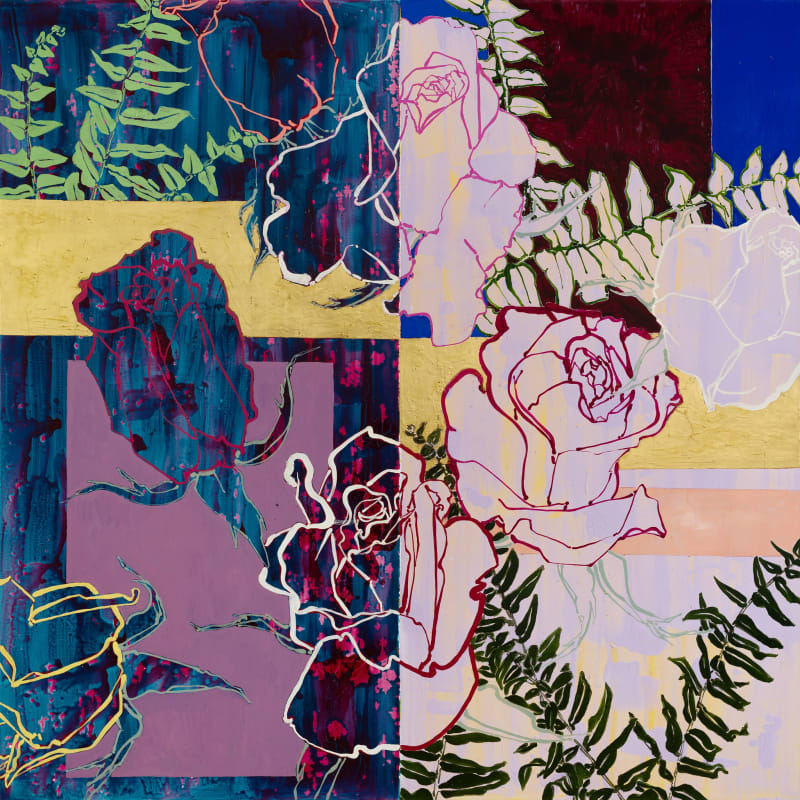Galerie Nathalie Obadia is delighted to present the work of American artist Robert Kushner for the first time. Born in 1949, in California, he was a key figure of the Pattern & Decoration movement, which was founded in the late 1960s - early 1970s in New York, where he still resides today. Robert Kushner created work that evolved in opposition with the minimal and conceptual art that dominated at the time; and he championed, instead, a return to motif, to ornamentation, to aesthetic pleasure according to Western and Eastern influences, and a clear interest in overlooked art forms.
For this first collaboration, the gallery presents a group of recent oil, acrylic, and palladium - and gold-leaf paintings, in a large spectrum of colors. His works incarnate this happy syncretism, which fully embraces its decorative function.
In 1967, Robert Kushner attended the prestigious University of California, famous for its very avant-garde visual arts program. There, he distinguished himself with his humorous, iconoclastic performances, and trained under professor and art critic Amy Goldin, who would later become the great theorist of the Pattern & Decoration Movement. In 1974, the artist accompanied her on a decisive journey through Turkey, Iran and Afghanistan, along the ancient Silk Road. He was exposed to Byzantine churches, weavers, bazaars, and carpet dealers in Istanbul, to Persian miniatures, and to Islamic architecture and art, all of which led him to discover the historic, cultural and aesthetic dimensions of ornamentation in terms of both principle and style: "It was then that I realized that there was a whole other way to consider decoration." It was over the course of this journey that Robert Kushner cemented his already budding practice.
Upon returning to New York, Amy Goldin organized numerous exchanges with students and young artists, including Miriam Schapiro, Valérie Jaudon, Robert Zakanitch and Joyce Kozloff. In so doing, she began to lay down the theoretical foundations of a new current that would put "visual arts" and "decorative arts" on equal footing, revaluing artisanal traditions and disciplines that were conventionally reserved to women, such as needlework. All these ideas, which were, at the time, on the margins of the avant-garde, motivated artists to turn toward other, non-Western cultures, from which Robert Kushner himself would continually find sustenance.
« To please the eye and satisfy the human soul »
In an America marked by a puritanical atmosphere, which was somewhat wary of "beauty" and ornamentation, this posed a dual challenge. The idea here was of transcending the hackneyed debate between abstraction and figuration, of rehabilitating pure visual pleasure and, thus, of proposing a fruitful contradiction to the artistic landscape of that time. The Holly Solomon Gallery, in SoHo, provided both a home base for the movement and also the site of its first success, with a group show in 1976. Soon after, Robert Kushner had his first solo exhibition at the same gallery and the movement rapidly spread to Europe, where several institutions and media outlets shifted their attention onto this artistic current that had originated in the United States. Despite virulent, though predictable, criticism, berating a "minor" or "frivolous art," the Pattern & Decoration Movement was met with tremendous success until the 1980s. It would continue to inspire Robert Kushner's particularly prolific work, which is characterized by its interplay between techniques from diverse artistic professions.
Taught to crochet by his grandmother, Robert Kushner first worked as a carpet restorer. Later, he learned to weave from a family in India. During a trip in 1982, he discovered madras and Indian mandalas, which he incorporated into his stylistic vocabulary. His taste for fabrics and, by extension, for costumes and fashion, is visible from the outset in a series of Iranian tchadors and painted curtains, and later penetrates his hybrid works where painting juxtaposes silk, taffeta, and cotton. Robert Kushner also looked at West-African Kente fabrics, macramé, 18th - century - French art and silk from Lyon.
This is not the only point in common between Robert Kushner and Henri Matisse, who was also a great collector of fabrics and an admirer of all sorts of motifs. Drawing-intimately linked to color, itself the essence of art -, the practice of collage, the Oriental inspirations were all part of the artist's espoused lineage, and a recent series explicitly pays homage to it. The precious refinement of gold leaf - one of Robert Kushner's signature - and the floral exuberance of his compositions also bring to mind Gustav Klimt and the Symbolist movement, while the intentional flatness and visual profusion are reminiscent of Edouard Vuillard.
The often stylized flowers have actually, since the 1980s, been a permanent fixture in Robert Kushner's work, which has also been compared to Georgia O'Keefe's: chrysanthemum, hibiscus, calendula, inspired by Hindu temples; calligraphic flowers set elegantly against gilded or dark backgrounds; delicate vegetation reminiscent of traditional Chinese or Japanese painting... In fact, when the artist discovered these, he became passionate about them and, in particular, about the Rinpa School, following a trip to Japan in 1985: known for having marked the tradition of decorative Japanese painting since the early 17th century, this school no doubt impelled Robert Kushner to work, in the 1990s, with gold leaf and floral motifs, and especially to create his own wall panels and folding screens, as evidenced by the geometric backgrounds of the presented works.
Lyrical, joyous, refined, Robert Kushner's oeuvre is as seductive as it is rich in all these elegantly assimilated influences. At a crossroads of traditions, cultures, artistic practices-the artist had also notably worked on sculptures and scenery-, this work inscribes itself in a parallel history that was recently restored to its honor by museum exhibitions in Los Angeles, Vienna, Geneva, and at the Dijon Consortium.

